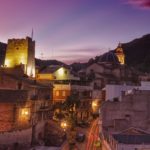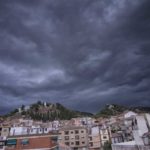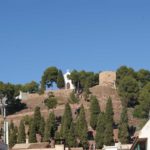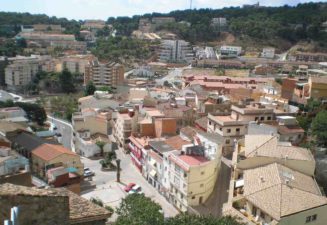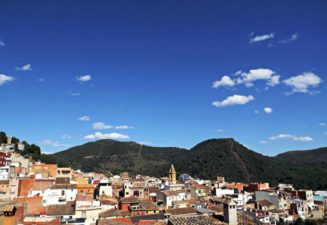History
Serra, a historic road to València
Serra is located in the heart of Serra Calderona, just at the centre of a strategic mountain pass that communicates the valley of the Palancia river, to the north, and the plain of València, to the south. The mountain pass between Serra and Torres-Torres was the shortest way from Aragon to València (or vice-versa), either on foot or on horse. This way, travellers did not have to border Serra Calderona through Sagunt, which meant taking a long turn, and also could avoid taking other mountain passes with a more difficult access.
Throughout history, this mountain pass has been the usual path for travellers, mail and armies. The different cultures that historically have lived on Valencian territories established their settlements on Serra. Many medieval fortifications were built to be used as sentry towers
Torres de Serrans (Serrans Gate)
It has been said (without much of a historical base) that the name of the Torres de Serrans (one of the city gates of València, from the 14th century) comes from the fact that they were used by villagers arriving from the county of Els Serrans (La Serrania) to enter the city. This was probably not true. The traditional entry to València was located following the road that lead to the city from the town of Llíria, and probably all the people from La Serrania and El Racó d’Ademús came this way. Then, they would cross the bridge of Sant Josep and the gate of Portal Nou to get into València. Portal Nou used to be just at the beginning of Llíria Street (currently, and since 1905, Salvador Giner Street).
However, the gates of Serrans were usually reached by the people from Serra, and from all the villages on that route as well. During centuries, they brought to the city products from the harvest, the mines and the forest. This was the entry as well for those travellers that came from Aragon and Catalonia and took either Serra’s mountain pass or the Royal roads to get into the city. Besides, it is known that medieval city gates usually took the names of the towns and routes that lead to them. For instance, we have the Torres de Quart (Quart Gates): people from the town of Quart, as well as from other villages along the same road, would access the city through these gates, thus giving them the name of Quart (which, in turn, is named after an ancient signal present on Roman roads). Moreover, beyond the Torres de Serrans –once inside the city– we will find ourselves in Náquera Street and then in Serrans Street, at the end of which once stood the home of the Boïl de l’Scala family, Lords of Manises, who were also Lords of the Barony of Serra for a while.
How old is Serra?
Human presence in Serra goes back to prehistoric times. In various archaeological sites, several pieces of silex and black pottery have been found, some of them belonging to the Neolithic, but most of them to the Valencian Bronze Age. There are records of at least three Iberian settlements on Serra’s ground: Alcalà, Ria and Porta Coeli. There are also remains from the Roman times, such as the old settlement of Ria.
And so, Serra’s ground has been a place where several settlements and villages were once established. The current urban centre is believed to have been founded during the Muslim period. Therefore, the remains of Ria are quite older. On the other hand, four villages are known to have existed during the Middle Ages: it is the case of Armell (in the area of Mugró), Lullén (in the surroundings of the current country house of La Pobleta), Rocafall (near La Torre), and one Muslim village of unknown name, which was the foundation place of the Carthusian monastery of Santa Maria in Porta Coeli.
Medieval Serra
The origins of the current town of Serra could go back to the first centuries of the Arabic occupation. In the year 711, the Arabic invasion of the Iberian Peninsula starts, and in a few years it reaches Valencian territories. With time, many castles and sentry towers were built such as the ones we find near Serra. Due to its strategic value, many defensive structures were built near Serra’s mountain pass. Along with Serra’s castle, there were also several sentry towers: the towers of Ria, of L’Ermita and of Satarenya, as well as the tower of El Senyor de la Vila (the tower of the Lord of the Village), which is in the town centre. During that period, along with the village of Serra, several hamlets were scattered around the area.
In the 11th century, the Moorish king Al-Qadir, pretender to the Kingdom of Valencia, set his encampment near Serra. He was accompanied by Álvar Fáñez, who was related to Rodrigo Díaz de Vivar, aka El Cid Campeador. Here, the keys of the city were given to Al-Qadir. Soof after, El Cid conquered València as well as Serra.
1232 marks the beginning of the conquest of the Kingdom of València by Jaume I. Serra was conquered by Christian troops and 1240 is given to the nobleman Gauteri de Roma, as it is recorded on the Llibre del Repartiment. This book contained all the promises made by future King Jaume I to his allies in the conquest. Therefore, Serra and its hamlets, hearths, mills and castle now belonged to Gauteri de Roma. Later, the property of Serra would go to the Bellpuig family, then to the counts of Prades, and then to the Boïl de l’Scala family. It went on like this until it was finally given to the Folch family of Cardona. They remained the town lords until lordships were abolished in the 19th century.
After King Philip III of Spain ordered the expulsion or Moriscos (Spanish Moors converted to Christianity), Serra was left practically uninhabited. On the 26th of November in 1609, its Lord, Josep Folch of Cardona issued a Carta Pobla (town charter) to promote the arrival of newcomers: mainly Old Christians coming from Alcublas, València and other neighbouring towns.
The strategic value of Serra’s mountain pass became relevant again during the armed conflicts that occurred over the last centuries. At the ending of the 19th century, Carlist troops following commanding officer Josep Santés passed through Serra heading to Valencia.
During the last Spanish Civil War, members of the Government of the Second Spanish Republic stayed in Serra and in the neighbouring town of Náquera. The road to Torres-Torres, which historically had been nothing but a bridleway, was rebuild, and fortified with machine guns and trenches in order to protect the mountain pass from the advance of Francoist troops. Manuel Azaña, the president of the Second Spanish Republic, established his residence at the country house of La Pobleta (the old Muslim settlement of Lullén). Around it, a considerable set of military posts and artillery guns were installed. When the war was finished, the Doctor Moliner Hospital in Porta Coeli became a concentration camp for Republican prisoners.






